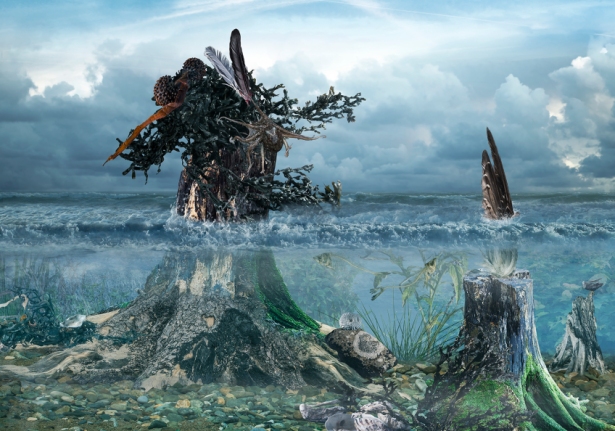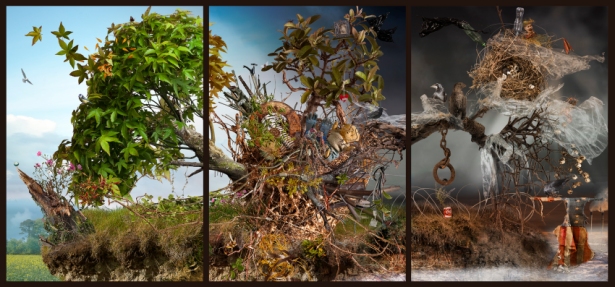This post comes from the Artists and Climate Change Blog
“Art could help us to question our perceptions and relationships to the climate and its changes. Artistic explorations should not be restricted to illustrating our scientific discoveries, as is done in contemporary climate-change showcases. Art should instead help us to experience and reveal our inner participation with climate, the rupture of its balance and its meaning for our inner world, in the same way that landscape artists reframed the relationship of humans to their environment.â€
—Julien Knebusch, The Perception of Climate Change (2007)
I have always loved the idea of using art to advance social causes, to make us reflect and rethink what it means to be human today. My artwork is an ongoing exploration of the unresolved environmental concerns of this century. It attempts to define the world we live in by contrasting aspects of a disintegrating planet with the beauty of all living things. Yet despite this overwhelming beauty, the reality is that we are on a precipice of extinction, balancing on the edge of a global meltdown. The ravages of climate change have already been experienced in the form of more frequent floods, violent storms, drought, and the destruction of wetlands and other natural habitats. All of this has contributed to the loss of tens of thousands of species of animals, birds, and bees. As human beings, we are dependent on Nature for our survival. Everything humans need to survive and thrive has been provided by our natural world: food, water, medicine, materials for shelter, etc. Supplies of coal, gas, water, steel, wood are seen as infinitely available. Technology and industry have distanced us from nature, but our reliance on the natural world is still as important as ever.
How do we make climate change real? Many of us have difficulty recognizing the link between our environmental problems and the way we live. A large percentage of the world’s population doesn’t feel the effects of climate change, unlike the farmer who works the land, the fisherman who harvests the sea, people living in low-lying coastal areas, and inhabitants of drought-ridden developing countries. One of the consequences of urban lifestyles, industrialization, capitalism, nationalism, the global economy, and social divides is that we have lost our connection to the natural world. These deep divisions are preventing us from addressing the problem collectively. We must recognize that because of our carelessness and neglect of our planet, climate change has become the greatest threat to future generations. Those least responsible for the damage will have to carry the greatest burden. Is this really the legacy we want to leave?
What role can the artist play in this debate about the environment?
The informed artist is an observer. The artist can ask questions, help shape our understanding of the world, open up hearts and minds to new ways of thinking, and offer visual interpretations of various global issues. Through my own personal practice, I express my concerns by adopting a balance between realism and surrealism. When attempting to open up people’s perspective, it is important that art be presented in a language that is accessible. Ultimately, I hope I can communicate the idea that if we manifest a positive outlook, protect, nurture, and realize what we have, we  can make a difference. Change needs to be radical, both globally and politically. We need to consume less, destroy less, conserve more, and embrace the abundance of renewable energy resources. If we want to protect future generations, immediate action is required before it is too late.
Everything is (Dis)connected and A Question of Balance are part of my “Split World†series. Water divides the images, creating two separate worlds; one above, one below, each with their own message to the viewer. I use water in many of my images, such as in Plastic!, to create scenarios that communicate the devastating effects of rising sea levels, pollution, melting ice caps, etc. The images are messages of beauty presented at the dawning of the apocalypse. They warn of what the future might hold. They question our failure to integrate with the natural world, our failure to realize that we are dependent on our planet to survive, our failure to take responsibility and acknowledge the consequences of our actions.
The Erosion of Eden and Coming Undone make use of the triptych format. Both images depict one scene: a landmass that provides a rich, unkempt, and decaying environment. Both of these eroded landmasses are strewn with “found†objects, some a testament to the throw-away society we live in, others gifts from nature. They serve as symbols of hope, negligence, reverence, destruction, ignorance, awe, and desolation. All reference mortality, impermanence, and the widespread and consequential harm that is being done to plants and animals that are trying to adapt to new conditions. The use of the triptych format differs in both images; The Erosion of Eden depicts one moment in time and Coming Undone portrays different instants, albeit the same location. The panels descend from a heavenly, idyllic scene to a world in ruins. It could be said from heaven to hell!
Artists throughout history have made significant contributions to social, political, and environmental challenges by using their creative practice to reflect upon and confront the issues at hand. If we are to alter, even reverse climate change, we need to reach out to people through their emotions to inspire action. Art is one of the ways of doing this.
(Top image: Everything is (Dis)connected.)
______________________________
Christine Simpson lives in County Waterford, Ireland. She is employed as a Lecturer on the BA (Hons) Design Communications and BA (Hons) Fine Art at Waterford Institute. Outside of academia, Christine is a practicing artist. Recently, the National Museum of Living Treasures in Tokyo purchased The Erosion of Eden, and she was invited to show at The Royal Hibernian Academy in Dublin. She has received numerous awards including the Waterford Crystal Arts Award; a Gold Award from Graphis, New York; and The Silken Photo Award, Brussels. She was shortlisted in the top ten for the Sony World Photography Awards. Christine’s work is in many private collections.
About Artists and Climate Change:
Artists and Climate Change is a blog that tracks artistic responses from all disciplines to the problem of climate change. It is both a study about what is being done, and a resource for anyone interested in the subject. Art has the power to reframe the conversation about our environmental crisis so it is inclusive, constructive, and conducive to action. Art can, and should, shape our values and behavior so we are better equipped to face the formidable challenge in front of us.





